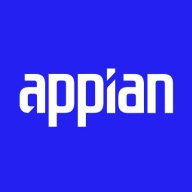

Appian and OpenText Operations Orchestration compete in business process management and IT operations automation. OpenText is often seen as the more worthwhile investment due to its comprehensive feature set.
Features: Appian offers low-code rapid application development, making it suitable for flexible, speed-focused organizations. It supports business process workflows with a focus on enterprise-wide adaptability. Its integration capabilities with existing systems are robust, and it facilitates quick deployment of applications through intuitive interfaces. In contrast, OpenText Operations Orchestration excels in IT process automation, emphasizing infrastructure management and integrations within existing IT ecosystems. It provides a centralized platform for automating complex IT operations, comprehensive workflow control, and simplifies administration across extensive server estates.
Room for Improvement: Appian could enhance its feature set for deeper IT infrastructure management and refine its complex integration processes to support specialized IT needs. Improvements in scalability options and additional in-depth technical support for more extensive systems would be beneficial. OpenText could simplify its deployment process and lower the technical expertise required for initial setup. Offering a more user-friendly interface and reducing the complexity of its customization options would also enhance accessibility for non-IT-focused users.
Ease of Deployment and Customer Service: Appian's cloud-based model ensures straightforward implementation, catering to enterprises looking for quick scaling without heavy infrastructure investments. Its customer service is highly supportive and user-focused, making it accessible for broader business audiences. OpenText's deployment is more complex with its on-premise requirements and demands significant IT resources. Its customer service is robust but tailored towards technical environments, often necessitating expert handling.
Pricing and ROI: Appian provides a flexible pricing structure, often associated with appealing initial costs, resulting in quick ROI due to its easy deployment and fast project turnarounds. OpenText, while requiring a higher upfront investment, offers substantial ROI for large-scale IT operations needing deep insights and management capabilities. Its extensive feature suite justifies the higher investment for organizations targeting comprehensive IT automation.
Using Appian is saving us five full-time employees, which is significant since we currently have only four team members.
They see return on investment in terms of cost savings, time savings, more efficient processes, and more efficient employees.
Appian is very efficient, allowing us to build a lot of applications within a financial year, making it cost-effective.
I would give Appian's customer support 10 out of 10 due to their next-level support.
The technical support for Appian rates as 10 out of 10 because they have a great support team.
Their customer service is responsive, and the team is very prompt for support.
On a scale of one to 10, Appian rates as a nine for scalability.
Our volume has increased by 20% in the two years since using Appian, and it can handle the increased volume effectively.
Appian is scalable, but it depends on how you build your applications.
We have tested Appian during peak usage and off-peak times, and we have not experienced any issues such as lagging or system disruptions.
It depends on how it has been designed and how it has been configured.
The stability of Appian would rate as nine, as it's a stable environment.
If Appian can suggest the country based on that address, it would significantly decrease error rates in processing remittance.
It has room to improve for use cases where the users are public facing, where anonymous users could come to a site and run a business workflow or interact with some data.
If there is a very complex process that includes a lot of data transitioning and memory-centric processes, it consumes a lot of memory.
Appian provides value for money, is easy to use, has a straightforward setup procedure, and offers great support from the Appian team.
On the pricier side, both Appian and Pega are enterprise-level solutions, placing them on the slightly higher side.
The pricing of Appian is based on the number of users and generally ranges from 70 to 100 USD per user per month.
Previously we could process only five to ten transactions within an hour, but now, after switching to Appian, we can process about 100 transactions in an hour, making it 10 times faster.
Appian is aiding in leveraging AI technologies in multiple ways: one way is for developers, as they make development efficient and quick by enabling developer co-pilots across various phases of the application, which helps design Appian quickly and provides suggestions along the way.
The zero-code integration feature is remarkable, allowing for ease of data transfer and workflow enhancement.
| Product | Market Share (%) |
|---|---|
| Appian | 5.0% |
| OpenText Operations Orchestration | 0.9% |
| Other | 94.1% |


| Company Size | Count |
|---|---|
| Small Business | 20 |
| Midsize Enterprise | 9 |
| Large Enterprise | 42 |
| Company Size | Count |
|---|---|
| Small Business | 4 |
| Midsize Enterprise | 2 |
| Large Enterprise | 20 |
Appian is a unified low-code platform and solution used by businesses to build enterprise applications and workflows. This product adapts to the needs of clients and the technologies they are already using to combine their data in a single workflow and maximize resources. The platform has four main components through which it transforms the work process for companies of various sizes. They are:
Appian is utilized across a diverse set of industries, including automotive and manufacturing, energy and utilities, education, financial services, telecom and media, transportation, retail, insurance, healthcare, and life sciences. The most frequent use cases of Appian are customer journey, governance, risk and compliance, operational efficiency, supply chain, distributed order management, and environmental, social, and governance (ESG) management.
Appian Features
Appian has various features that allow users to create solutions for their businesses. These features can be separated into a few groups according to function, including automation, low-code application development, and integrations and data. Some of the most frequently used features of Appian include:
Appian Benefits
The benefits of using Appian include:
Reviews from Real Users
A practice leader - digital process automation at a computer software company values Appian highly because the product is easy to develop, low-code, and has a good user interface.
Alan G., an advisory board member at Codecon VR, Appian offers a clear application life cycle, easy to learn documentation, and comes with a fundamentals course.
OpenText Operations Orchestration (OO) automates, integrates, and orchestrates any IT process, on cloud or off. Automate using low-code/no-code workflow authoring options. Integrate with an API rich, extensible platform. Centrally orchestrate powerful, scalable workflows.
With OO you can automate and orchestrate infrastructure automation and IT processes from service fulfillment to incident remediation, cloud service delivery, and disaster recovery.
Operations Orchestration offers the tools needed to provide enterprise wide orchestration capabilities:
Operations Orchestration offers the following components:
We monitor all Process Automation reviews to prevent fraudulent reviews and keep review quality high. We do not post reviews by company employees or direct competitors. We validate each review for authenticity via cross-reference with LinkedIn, and personal follow-up with the reviewer when necessary.